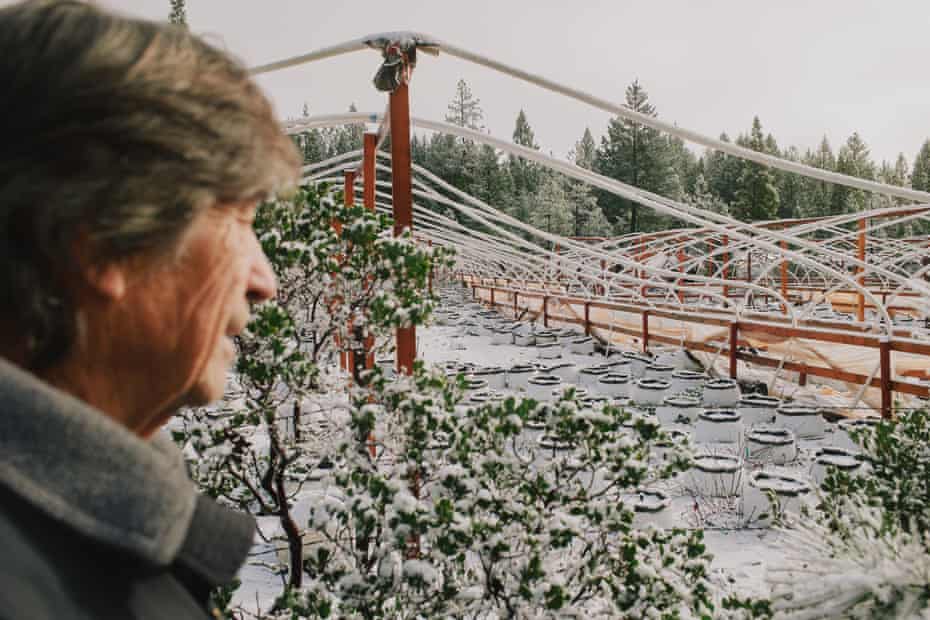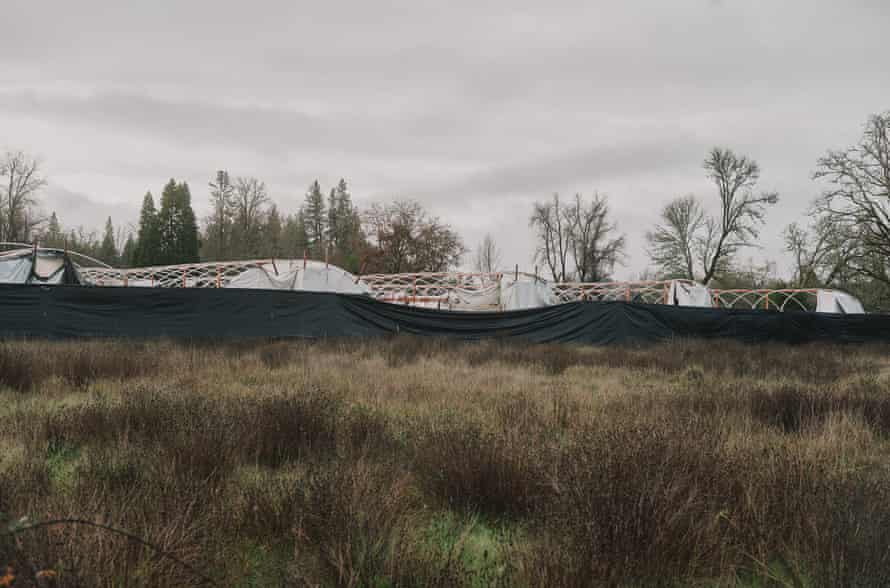Christopher Hall parks his old Toyota on a dirt road that dead-ends in a forest in Oregon’s Illinois Valley. He points out a cluster of greenhouses surrounded by piles of trash, and the hillside above, which has been terraced and entirely stripped of vegetation. Guard dogs run through a small clearing, barking at us.
Two men pull up almost instantly in a Honda with busted headlights; the driver asks Hall what he’s doing there. For a bespectacled middle-aged conservationist, Hall is surprisingly reckless. Even though he can see the men are armed, he yells back at them: “Where are you from? We know what you’re doing here is illegal! How many plants are you growing?” One man says they’re from Serbia and claims they have a license to grow as another truck pulls up.
I tell Hall I think we should move on, and he reluctantly shifts into drive but is unable to resist a few parting shots: “Do you think you can just keep trashing our streams? Have some respect for the land!”
This part of south-western Oregon – which encompasses Josephine, Jackson and Douglas counties and was settled by goldminers in the 1850s – has always kept a touch of the wild west anti-authority streak, contributing to its status as a stronghold of illegal cannabis farms since the 1960s.
Pot was legalized for recreational use in Oregon in 2015, making it legal for any person to grow up to four plants. But in the past year, longtime locals have been alarmed by the rapid proliferation of unlicensed pot farms, unprecedented in terms of size and allegedly controlled by crime syndicates from eastern Europe, China and Mexico.
Hall, community liaison for the Illinois Valley Soil and Water Conservation District, has been flying over the region in a single-engine plane to map illegal pot farms and has pinpointed 1,030 clusters of greenhouses on just 20 miles of the valley, 80% of which he estimates are illegal. Local authorities agree with that estimate. These large grows have flooded the market – a pound of cannabis that was worth $3,000 in 2009 here might now fetch $400, all but killing the industry for small-time legal growers.
County officials say they have been inundated by hundreds of complaints from locals who accuse “crime syndicates” of stealing their farm equipment and their water. Hall documents the impact of the illegal farms depleting aquifers by pumping from protected rivers and digging huge pits to tap into the groundwater. “It takes an act of God to get a water right in Oregon, so they just don’t bother. They just dig holes,” he says. “One of the biggest complaints this year is that people’s wells are underperforming or just drying right out,” he says. “The threat to the environmental health of the region cannot be overstated. The community is upside down.”

Jackson and Douglas counties declared a state of emergency in October and asked Governor Kate Brown for state funding for more enforcement personnel because local authorities are overwhelmed. This request is not unprecedented. The national guard have participated in pot raids since 1989, when Operation Green Sweep descended on the nearby Emerald Triangle, California’s most prolific weed region, the tip of which touches southern Oregon. Those raiders saw 1,300 cannabis plants destroyed, and locals protested against that deployment of federal troops to small farms. In 2019, government raids destroyed 953,459 plants in California. It’s the same story in Oregon, where busts on large grows now yield tens of thousands of plants.
“When I say cartels, I’m not talking just Hispanic,” says the Josephine county sheriff, Dave Daniel, who welcomes the idea of state and federal help. “I’m talking Bulgarian, Ukrainian, Chinese, east coast drug trafficking organizations.”

Daniel, who has been sheriff since 2015, is a big man with close-cropped silver hair. “The 2021 grow season was the most brazen, in your face, wide open that I’ve seen yet,” he says. He describes farms where crews of migrant workers live under armed guard, without refrigeration or sanitation. “They rule by fear of injury and death. They human-traffic. We know that,” he says of the cartels.
With a team of just three detectives, Daniel doesn’t have the manpower to properly tackle the problem. “Have you ever seen the movie Animal House?” he asks. “Kevin Bacon is in his little police or military uniform and he’s got his hands in the air and he says ‘Remain calm, all is well’ and then completely gets mowed over by the crowd? That’s me. That’s Josephine county law enforcement right there.”
A big part of the problem is rooted in the legalization of industrial hemp, which looks and smells like marijuana but won’t get you high. Since 2010, it’s been legal to grow hemp in unlimited quantities. After the hemp market crashed in 2018, some farmers began hiding psychoactive cannabis plants in their hemp fields and many more leased their properties to out-of-state operators who claimed they planned on growing hemp.

This ruse allows criminal organizations to grow on a vast scale. Douglas county law enforcement recently raided two supposed hemp farms they believe are operated by the same cartel and seized a total of 122,000 cannabis plants – nearly 50 times the quantity of plants that can typically be grown under a recreational cannabis license. In another Douglas county raid this November, police seized 500,000 pounds of weed, which they estimate is worth $500m.
Although Governor Brown declined to send in the national guard this harvest season, which ended mid-November, Daniel hopes he will have the state’s support next year.
“We’re in close contact with the governor and our federal partners are starting to open their eyes. I’ve talked to the FBI, and the DEA. And everyone is going, ‘Something’s not right in southern Oregon.’”
Communities here used to be close-knit. Unlicensed pot farms abounded, but the growers were largely local people and thus had some sense of accountability to one another and the environment.

Nicole Rensenbrink, a social worker who is married to the local veterinarian, has lived in Josephine county since 1983 and laments how much it has changed in recent years, describing “the endless ugliness that the huge influx of cannabis farms has brought to our valley”. She says their once-picturesque drive to work is “riddled with ugly plastic hoop houses, fencing and industrial-looking buildings,” – all the makings for large-scale pot grows. She has to keep her dogs away from the creek that runs through her property because it’s full of “nasty looking slime”; she blames fertilizer run-off from the unregulated farms.
Tim Freeman, a Douglas county commissioner, says for some locals the issue goes beyond dismay over a changing landscape. “When residents call in, they are scared,” Freeman says. “They are scared about where they live, afraid of what’s going on around them and, in many cases, they are afraid to leave their homes.”
Terra and Jerry Palmer live in a shingled one-room cabin that Jerry built 30 years ago. The couple were saving up to build a bigger house on their land, but are considering moving because of an illegal grow that moved in nearby last year. Terra describes constant traffic on their country road, a steady stream of “pickup trucks full of young men”, cars without license plates, and trucks full of cannabis. Hundreds of trees Jerry planted over the years have started to die off due to a lack of water.
“I’m really discouraged because this year the creek went dry two months earlier than it’s ever gone dry during the all years that I’ve been here,” Jerry says.

The couple have not confronted their neighbors. They fear reprisals and asked that their names be changed.
Terra and Jerry may look like typical older hippies, but they come off as conventional when discussing the consequences for breaking the law on such a large scale. “Confiscate the property and jail landowners who knowingly lease land to illegal growers. Deport illegal migrant workers,” Terra wrote in a letter beseeching authorities to take action.
A migrant, mostly undocumented, workforce is required to farm on the scale southern Oregon is dealing with now. Sheriff Daniel is less aggressive on the subject of those workers. “We don’t look into immigration status. State law doesn’t allow us to,” he says. “Which is fine. I treat these workers like they’re victims, to be honest with you. Which I think in large part they are.”

Kathy Keesee-Morales is the program coordinator for the Unete Center for Farm Worker Advocacy, an organization that lobbies for worker rights and provides support to the migrant community. Bosses withholding pay and substandard living conditions are the most prominent issues her organization has to address in relation to cannabis farms.
“There were some pretty extreme cases. There’s farms where there were young children living in what someone referred to as squalor. They were sleeping under black plastic tarps inside the hoop houses,” she says.
About half of the 200 complaints of wage withholding they received in 2021 are from workers who have been abused, like the man who said when he tried to leave the farm his boss put a gun to his head and threatened his family.

Large pot farms with armed bosses aren’t where most of the migrant workers planned to end up. But last year, wildfires swept through the region, immolating the nearby towns of Phoenix and Talent. This year was so dry the governor had declared a state of drought emergency by June. “So these farm workers that were depending on harvesting the orchards and the grapes to be able to survive – literally survive over the summer and save up money for the winter – they didn’t have anywhere to go except to work for these [cannabis] farms,” Morales says.
The threat of violence isn’t limited to workers. “I’ve had a homeowner who leased out his property, but then he realized it wasn’t actually just a hemp grow,” says Sheriff Daniel. “He started questioning one of the soldiers – managers, soldiers, whatever you want to call it – and they threatened to burn his house down. They said, ‘We can take care of this real quick. One match. So mind your own business.’”
The abuse of workers, environmental degradation and threats of violence towards locals have pushed some residents who have historically been skeptical of federal drug enforcement to ask for exactly that. Cedar Grey and his wife, Madrone, own Siskiyou Sungrown, a seven-year-old permitted cannabis farm with 5,000 plants, which is large for a legal operation. But he has been growing cannabis in this area since 1998, the year Oregon legalized marijuana for medical use.

“Our local government seems to spend more time enforcing compliance on legal cannabis farms than even visiting illegal cannabis farms,” Cedar says. “That’s incredibly frustrating to legal cannabis farms. The amount of money we spend and the hoops that we jump through to be compliant with regulations – it’s mountainous, it’s unbelievable,” Cedar says.
To ensure licensed cannabis farms aren’t selling on the illicit market, Oregon law requires that farmers document every scrap of plant material they grow – from seed to sale. Growers are responsible for tagging and tracking every single plant. And all work must be done on camera – even the farm’s compost piles are under surveillance. If they snip a leaf from a branch, they have to weigh the clipping and report it to the Oregon Liquor and Cannabis Commission, the organization that strictly monitors all legal pot farms. Grey estimates he has spent $150,000 for cameras, video, alarms and tracking systems in the last seven years.
“I mean it’s really, really strange for me to be calling for a huge law enforcement or military crackdown on growing marijuana because for so long I just wanted it to be free for people to grow,” Cedar says. “But what’s happening here has to stop. It’s too bad, it’s too wrong, and it’s too damaging. I fully support federal resources being brought, Oregon national guard and federal law enforcement coming in. Hit every one of these farms.”


Be the first to comment